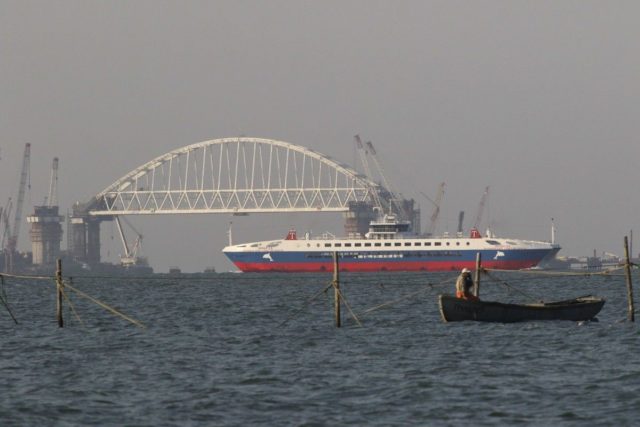
Russian Expansion in the Black Sea and the Sea of Azov: Economic Consequences for Ukraine
Publication: Eurasia Daily Monitor Volume: 15 Issue: 27
By:

Moscow’s appetite in the Black Sea and the Sea of Azov has not decreased after Russia’s annexation of Crimea in 2014. Russia has gradually advanced its presence into significant areas of the exclusive maritime economic zone of Ukraine, which, in accordance with international law, is subject to the sovereign rights of Ukraine. This expansion aims to establish control over critical maritime areas and transport communications nodes.
In violation of the UN Convention on the Law of the Sea, Russia is actively building the Kerch Bridge. On May 24, 2017, Moscow announced a restriction on the dimensions of the vessels passing through the central arch of the Kerch Bridge. Volodymyr Omelyan, Ukraine’s infrastructure minister, noted that about 50 percent of the merchant vessels loaded at the Mariupol’s “UkrTransAgro” port terminal last year would not meet the restrictions imposed by Russia. In fact, the losses of the Mariupol and Berdyansk seaports were tangible in 2017, mostly due to freight reduction by 43 percent and transshipment shrinking by 30 percent (Mtu.gov.ua, November 28, 2017, UNIAN, October 13, 2017, Censor.net, August 23, 2017). After the installation of the bridge arch in October 2017, these two Ukrainian ports on the Sea of Azov lost over $54 million in freight and transshipment. This figure is expected to be significantly higher in 2018. Despite the problems with the erection of the Kerch Bridge, which could lead to the Kerch Strait overlapping, the construction work continues (Umoloda.kiev.ua, February 14; UNIAN, February 17).
With the illegal annexation of Crimea in 2014, Ukraine lost 70 percent of its naval capabilities. Moscow has also unlawfully seized eight maritime gas fields belonging to Ukraine: the North-Bulganakske, East-Kazantipske and Strylkove (subsequently returned under Ukrainian control) gas fields in the Sea of Azov; and the Odeske, Holitsynske, Archangelske, Shtormove and Bezimyane gas fields in the Black Sea (RIA.ru, December 29, 2015, Radio Svoboda, September 12, 2017).
Svetlana Nezhnova, head of the Ukrainian state-owned company “Chornomornaftogaz,” notes that a total of 7.2 billion cubic meters (bcm) of gas has been illegally extracted by Russia from Ukrainian maritime gas fields in the Black Sea and the Sea of Azov since the annexation of Crimea (Oilreview.kiev.ua, February, 14). This volume amounts to $1.728 billion in Ukrainian consumer prices in 2017. Russia extracted the largest quantities of gas from the Odeske gas field, located near the Odessa port hub, beyond the continental shelf of occupied Crimea (Ukrinform.ua, April 28, 2014). In 2016, Russia started illegal drilling in the Holitsynske gas field, which has gas reserves of up to 100 billion cubic meters; and in April 2017, a new gas platform was put into operation at the Odeske gas field (Neftegaz.ru, October 28, 2015, Neftegaz.ru, January 22).
The northwestern part of the Black Sea has estimated reserves of 495.7 bcm of natural gas and 50.4 million tons of oil and condensate. The Prykerchenska zone holds about 321.2 bcm of gas and 126.8 million tons of oil and condensate; and the continental slope has an estimated 766.6 bcm of gas and 232.6 million tons of oil and condensate (RIA.ru, April 13, 2014). The estimated price of natural gas extracted from the continental shelf is about $50 per thousand cubic meters (Neftegaz.ru, May 15, 2014). The success rate of geological exploration in the Ukrainian continental shelf reaches 0.5-0.6, while the average world index is 0.3 (Informat.com.ua, July 20, 2017). Consequently, Ukraine’s sea reserves could serve to substantially increase domestic gas production. Kyiv is considering this opportunity as Gazprom is building pipelines to Europe that bypass Ukraine (Finance.ua, June 21, 2017). First, however, Ukraine’s sovereign rights in its littoral waters and its freedom of navigation need to be reliably protected against Russian maritime expansion.
In response to the Kremlin’s illegal maritime activities, Ukraine has filed a memorandum about Russia’s violation of the UN Convention of the Law of the Sea, as a part of a lawsuit at the International Tribunal for the Law of the Sea (Interfax.com.ua, February 15). At the same time, the critical weakness of Ukraine’s naval capabilities in controlling and protecting the country’s exclusive maritime economic zone could significantly reduce the effectiveness of Kyiv’s diplomatic efforts.
Ukraine urgently needs patrol boats and situation awareness assets to protect its national security against growing maritime threats. Taking into account Ukraine’s naval vulnerability, in December 2017, the US Congress approved a list of authorized assistance to Kyiv, which included coastal defense radars, naval mine and counter-mine capabilities and patrol boats (Ukrinform, December 13, 2017). Patrol boats designated for Ukraine have been waiting in the United States since last July, but Kyiv has yet to cover the cost of their transfer and training for their crews (Krymr, July 17, 2017). This is because Ukrainian law forbids the ministry of defense to directly procure weapons abroad, thus preventing the Ukrainian navy from receiving the boats donated by the United States.
On February 5, Ukrainian President Petro Poroshenko approved the decision of the National Security and Defense Council about the draft law “On the National Security of Ukraine” (Zakon.rada.gov.ua, February 5). “The draft law sets the goal of Ukraine’s membership in both the European Union and NATO, which should be an unconditional guarantee of the security, sovereignty and territorial integrity of our state,” Poroshenko noted earlier, underscoring the significant importance of this question (President.gov.ua, January 17). It also means that Ukraine should work to enhance its maritime security and become more proactive in strengthening its naval forces’ capabilities to protect national security and Ukraine’s sovereign rights at the Black Sea and the Sea of Azov.



